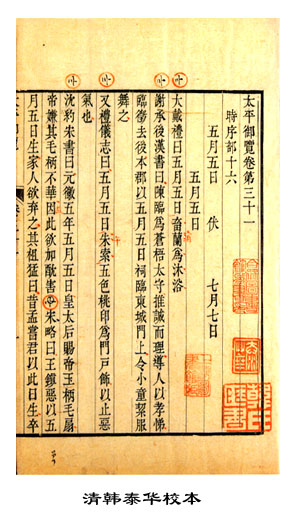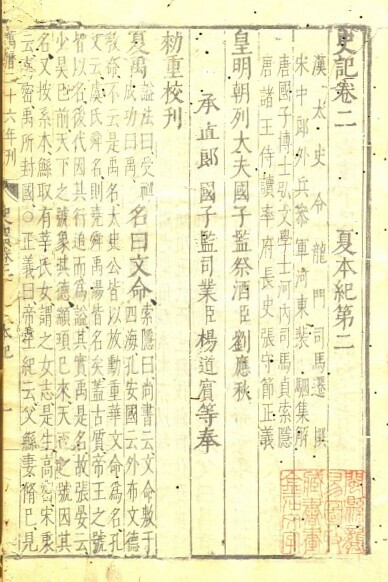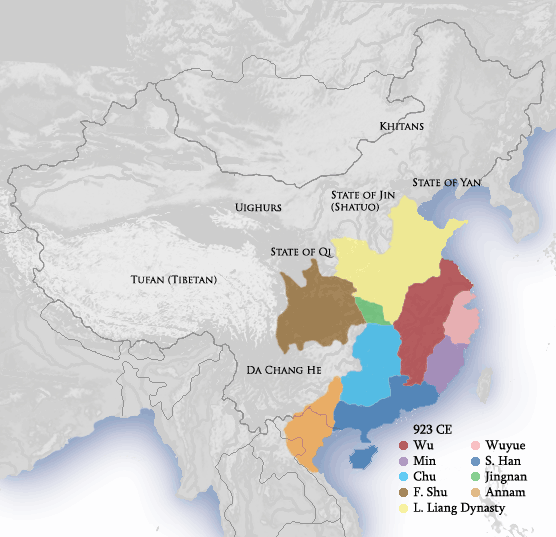|
Shiben
The ''Shiben'' or ''Book of Origins'' (Pinyin: ''shìběn''; Chinese; 世本; ) was an early Chinese encyclopedia which recorded imperial genealogies from the mythical Three Sovereigns and Five Emperors down to the late Spring and Autumn period (771–476 BCE), explanations of the origin of clan names, and records of legendary and historical Chinese inventors. It was written during the 2nd century BC at the time of the Han dynasty. The work was lost in the 10th century, but partially reconstructed from quotations during the Qing dynasty. Title The title combines the common Chinese words ''shì'' 世 "generation; epoch; hereditary; world" and ''běn'' 本 "root; stem; origin; fundament; wooden tablet". The personal name of Emperor Taizong of Tang (r. 627–650) was ''Shimin'' 世民, and owing to the strict naming taboo against writing an emperor's name, the ''Shiben'' 世本 title was changed to ''Xiben'' 系本 or ''Daiben'' 代本 (with the ''shi'' near-synonyms of ''xi'' ... [...More Info...] [...Related Items...] OR: [Wikipedia] [Google] [Baidu] |
Chinese Encyclopedia
Chinese encyclopedias comprise both Chinese language encyclopedias and foreign language ones about China or Chinese topics. There is a type of native Chinese reference work called '' leishu'' (lit. "categorized writings") that is sometimes translated as "encyclopedia", but although these collections of quotations from classic texts are expansively "encyclopedic", a ''leishu'' is more accurately described as a "compendium" or "anthology". The long history of Chinese ''leishu'' encyclopedias began with the (222 CE) '' Huanglan'' ("Emperor's Mirror") ''leishu'' and continues with online encyclopedias such as the '' Baike Encyclopedia''. Terminology The Chinese language has several translation equivalents for the English word ''encyclopedia''. ''Diǎn'' 典 "standard; ceremony; canon; allusion; dictionary; encyclopedia" occurs in compounds such as ''zìdiǎn'' 字典 "character dictionary; lexicon", ''cídiǎn'' 辭典 "word/phrase dictionary; encyclopedia", ''dàdiǎn'' 大� ... [...More Info...] [...Related Items...] OR: [Wikipedia] [Google] [Baidu] |
Three Sovereigns And Five Emperors
According to Chinese mythology and traditional Chinese historiography, the Three Sovereigns and Five Emperors () were a series of sage Chinese emperors, and the first Emperors of China. Today, they are considered culture heroes, but they were widely worshipped as divine "ancestral spirits" in ancient times. According to received history, the period they existed in preceded the Xia dynasty, although they were thought to exist in later periods to an extent in incorporeal forms that aided the Chinese people, especially with the stories of Nüwa existing as a spirit in the Shang dynasty and Shennong being identified as the godly form of Hou Ji and a founder of the Zhou dynasty. In myth, the Three Sovereigns were demigods who used their abilities to help create mankind and impart to them essential skills and knowledge. The Five Emperors were exemplary sages who possessed great moral character, and were from a golden age when "communications between the human order and the divine ... [...More Info...] [...Related Items...] OR: [Wikipedia] [Google] [Baidu] |
Small Seal Script
The small seal script is an archaic script style of written Chinese. It developed within the state of Qin during the Eastern Zhou dynasty (771–256 BC), and was then promulgated across China in order to replace script varieties used in other ancient Chinese states following Qin's wars of unification and establishment of the Qin dynasty (221–206 BC) under Qin Shi Huang, the first emperor of China. History During the Eastern Zhou dynasty (256 BC), local varieties of Chinese character forms had developed across the country, producing the 'scripts of the six states' ()—which were later collectively referred to as large seal script. This variance was considered unacceptable by the nascent Qin dynasty (221–206 BC), who saw it as a hindrance to timely communication, trade, taxation, and transportation, as well as being a potential vector for fomenting political dissent. Around 220 BC, Qin Shi Huang ordered a systematic standardization of th ... [...More Info...] [...Related Items...] OR: [Wikipedia] [Google] [Baidu] |
Records Of The Grand Historian
The ''Shiji'', also known as ''Records of the Grand Historian'' or ''The Grand Scribe's Records'', is a Chinese historical text that is the first of the Twenty-Four Histories of imperial China. It was written during the late 2nd and early 1st centuries BC by the Han dynasty historian Sima Qian, building upon work begun by his father Sima Tan. The work covers a 2,500-year period from the age of the legendary Yellow Emperor to the reign of Emperor Wu of Han in the author's own time, and describes the world as it was known to the Chinese of the Western Han dynasty. The ''Shiji'' has been called a "foundational text in Chinese civilization". After Confucius and Qin Shi Huang, "Sima Qian was one of the creators of Imperial China, not least because by providing definitive biographies, he virtually created the two earlier figures." The ''Shiji'' set the model for all subsequent dynastic histories of China. In contrast to Western historiographical conventions, the ''Shiji'' does no ... [...More Info...] [...Related Items...] OR: [Wikipedia] [Google] [Baidu] |
Former Shu
Great Shu ( zh, c=大蜀, p=Dàshǔ), known in historiography as the Former Shu ( zh, c=前蜀, p=Qiánshǔ, links=no) or occasionally Wang Shu (王蜀), was a dynastic state of China and one of the Ten Kingdoms during the Five Dynasties and Ten Kingdoms period. It existed from 907 to 925 CE. The country's name changed from "Shu" to "Han" ( zh, t=漢, p=Hàn, links=no) in 917–918, which is not to be confused with another contemporaneous kingdom during the same Five Dynasties and Ten Kingdoms period, the Southern Han Southern Han ( zh , t = 南漢 , p = Nán Hàn , j=Naam4 Hon3; 917–971), officially Han ( zh , t = 漢 , links=no), originally Yue ( zh , c = 越 , links=no), was a dynastic state of China and one of the Ten Kingdoms that existed during the ... ( zh, t=南漢, s=南汉, first=t, p=Nán Hàn, links=no), 917–971 CE. Rulers See also * Later Shu References * Further reading * {{DEFAULTSORT:Shu Five Dynasties and Ten Kingdoms Forme ... [...More Info...] [...Related Items...] OR: [Wikipedia] [Google] [Baidu] |
Sui Dynasty
The Sui dynasty ( ) was a short-lived Dynasties of China, Chinese imperial dynasty that ruled from 581 to 618. The re-unification of China proper under the Sui brought the Northern and Southern dynasties era to a close, ending a prolonged period of political division since the War of the Eight Princes. The Sui endeavoured to rebuild the country, re-establishing and reforming many imperial institutions; in so doing, the Sui laid much of the foundation for the subsequent Tang dynasty, who after toppling the Sui would ultimately preside over golden ages of China, a new golden age in Chinese history. Often compared to the Qin dynasty (221–206 BC), the Sui likewise unified China after a prolonged period of division, undertook wide-ranging reforms and construction projects to consolidate state power, and collapsed after a brief period. The dynasty was founded by Emperor Wen of Sui, Yang Jian (Emperor Wen), who had been a member of the military aristocracy that had developed in ... [...More Info...] [...Related Items...] OR: [Wikipedia] [Google] [Baidu] |
Natural History
Natural history is a domain of inquiry involving organisms, including animals, fungi, and plants, in their natural environment, leaning more towards observational than experimental methods of study. A person who studies natural history is called a naturalist or natural historian. Natural history encompasses scientific research but is not limited to it. It involves the systematic study of any category of natural objects or organisms, so while it dates from studies in the ancient Greco-Roman world and the mediaeval Arabic world, through to European Renaissance naturalists working in near isolation, today's natural history is a cross-discipline umbrella of many specialty sciences; e.g., geobiology has a strong multidisciplinary nature. Definitions Before 1900 The meaning of the English term "natural history" (a calque of the Latin ''historia naturalis'') has narrowed progressively with time, while, by contrast, the meaning of the related term "nature" has widened (see also ... [...More Info...] [...Related Items...] OR: [Wikipedia] [Google] [Baidu] |
Reference Works
A reference work is a document, such as a paper, book or periodical (or their electronic equivalents), to which one can refer for information. The information is intended to be found quickly when needed. Such works are usually ''referred'' to for particular pieces of information, rather than read beginning to end. The writing style used in these works is informative; the authors avoid opinions and the use of the first person, and emphasize facts. Indices are a common navigation feature in many types of reference works. Many reference works are put together by a team of contributors whose work is coordinated by one or more editors, rather than by an individual author. Updated editions are usually published as needed, in some cases annually, such as '' Whitaker's Almanack'', and ''Who's Who''. Reference works include textbooks, almanacs, atlases, bibliographies, biographical sources, catalogs such as library catalogs and art catalogs, concordances, dictionaries, direc ... [...More Info...] [...Related Items...] OR: [Wikipedia] [Google] [Baidu] |
Chinese Literature
The history of Chinese literature extends thousands of years, and begins with the earliest recorded inscriptions, court archives, building to the major works of philosophy and history written during the Axial Age. The Han dynasty, Han (202 BC220 AD) and Tang dynasty, Tang (618–907 AD) dynasties were considered golden ages of poetry, while the Song dynasty, Song (960–1279) and Yuan dynasty, Yuan (1271–1368) were notable for their lyrics (''ci''), essays, dramas, and plays. During the Ming dynasty, Ming and Qing, mature novels were written in written vernacular Chinese, an evolution from the preeminence of Literary Chinese patterned off the language of the Chinese classics. The introduction of widespread woodblock printing during the Tang and the invention of movable type printing by Bi Sheng (990–1051) during the Song rapidly spread written knowledge throughout China. Around the turn of the 20th century, the author Lu Xun (1881–1936) is considered an influential voi ... [...More Info...] [...Related Items...] OR: [Wikipedia] [Google] [Baidu] |
Wang Mo
Wang Mo (traditional Chinese: ; simplified Chinese: ; pinyin: Wáng Mó; Wade-Giles: Wang Mo) (1895 - 1958) was a politician and educator in the Republic of China. He was an important politician during the Wang Jingwei regime (Republic of China-Nanjing). He was born in Yilong, Sichuan. Biography Wang Mo went to Japan where he graduated the Tokyo Teacher's High School (; Now, the Tokyo University of Education, ) and the Tokyo Imperial University. Later he returned to China, he successively held the positions of Professor of the National University of Wuchang (), National University of Beiping (), Teacher's College () and Tsinghua University.Asahi Shimbun, November 12, 1943, p.2. And he was also elected to Senator of the Beijing Government. Later he worked as president of the National Teacher's University of Beiping (), from 1942, he also worked as a professor at this university. In November 1943, upon the North China Political Council () was reformed, Wang Mo was catapulted ... [...More Info...] [...Related Items...] OR: [Wikipedia] [Google] [Baidu] |
Song Dynasty
The Song dynasty ( ) was an Dynasties of China, imperial dynasty of China that ruled from 960 to 1279. The dynasty was founded by Emperor Taizu of Song, who usurped the throne of the Later Zhou dynasty and went on to conquer the rest of the Five Dynasties and Ten Kingdoms period#Ten Kingdoms, Ten Kingdoms, ending the Five Dynasties and Ten Kingdoms period. The Song frequently came into conflict with the contemporaneous Liao dynasty, Liao, Western Xia and Jin dynasty (1115–1234), Jin dynasties in northern China. After retreating to southern China following attacks by the Jin dynasty, the Song was eventually conquered by the Mongol-led Yuan dynasty. The History of the Song dynasty, dynasty's history is divided into two periods: during the Northern Song (; 960–1127), the capital was in the northern city of Bianjing (now Kaifeng) and the dynasty controlled most of what is now East China. The #Southern Song, 1127–1279, Southern Song (; 1127–1279) comprise the period following ... [...More Info...] [...Related Items...] OR: [Wikipedia] [Google] [Baidu] |








